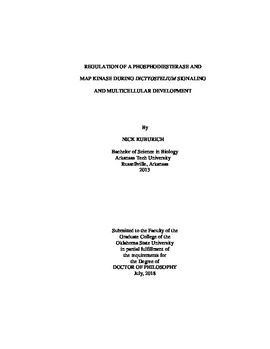| dc.contributor.advisor | Hadwiger, Jeffrey A. | |
| dc.contributor.author | Kuburich, Nick | |
| dc.date.accessioned | 2019-03-22T18:57:09Z | |
| dc.date.available | 2019-03-22T18:57:09Z | |
| dc.date.issued | 2018-07 | |
| dc.identifier.uri | https://hdl.handle.net/11244/317659 | |
| dc.description.abstract | Many eukaryotic signaling pathways use cAMP as a secondary messenger to evoke specific responses to different external stimuli. Here, localized levels of cAMP can be controlled by phosphodiesterases, which are sometimes regulated by phosphorylation. Dictyostelium discoideum offers an excellent model system to study signal transduction pathways such as the regulation of phosphodiesterases as it contains relatively few cAMP-specific phosphodiesterases compared to mammals. The cAMP-specific phosphodiesterase, RegA, regulates important steps in Dictyostelium development and is negatively regulated by the MAP kinase, Erk2. This inactivation occurs periodically by external cAMP pulse where a cell-signaling pathway activates Erk2. Mammalian studies have suggested that the cAMP-dependent protein kinase, PKA, can also regulate the phosphodiesterase activity. This putative regulation of PKA on the activity of RegA has not been fully investigated in Dictyostelium. Mass spectrometry was used to detect potential phosphorylation sites on RegA. Two sites of interest have been identified, including a PKA phosphorylation site. Phosphomimic and phosphoablative mutations for the three sites have been constructed. The phenotypes of cells carrying these mutations have been analyzed for their impact on development and cell fate. This study supports the hypothesis that RegA is regulated by multiple phosphorylation events to influence signaling during multicellular development. To study upstream aspects of this signaling pathway the erk2 gene in Dictyostelium was disrupted The absence of Erk2 resulted in a complete loss of folate and cAMP chemotaxis suggesting that this MAPK plays an integral role in the signaling mechanisms involved with this cellular response. Multicellular development was also impacted as was the phosphorylation of Erk1 as a secondary response to folate stimulation. Loss of the only known Dictyostelium MAPK kinase, did not impact Erk2 phosphorylation in response to folate and cAMP. This lack of MAP2K phosphorylation of Erk2 and the sequence similarity of Erk2 to mammalian MAPK15 (Erk8) suggest that the Dictyostelium Erk2 belongs to a group of atypical MAPKs. These studies of RegA and Erk2 suggests that Dictyostelium represents a good model for the study of the regulation of phosphodiesterases and atypical MAPKs. | |
| dc.format | application/pdf | |
| dc.language | en_US | |
| dc.rights | Copyright is held by the author who has granted the Oklahoma State University Library the non-exclusive right to share this material in its institutional repository. Contact Digital Library Services at lib-dls@okstate.edu or 405-744-9161 for the permission policy on the use, reproduction or distribution of this material. | |
| dc.title | Regulation of a phosphodiesterase and map kinase during dictyostelium signaling and multicellular development | |
| dc.contributor.committeeMember | Prade, Rolf A. | |
| dc.contributor.committeeMember | Lutter, Erika Ildiko | |
| dc.contributor.committeeMember | Ruhl, Donald Dean | |
| dc.contributor.committeeMember | Miller, Rita K. | |
| osu.filename | Kuburich_okstate_0664D_15889.pdf | |
| osu.accesstype | Open Access | |
| dc.type.genre | Dissertation | |
| dc.type.material | Text | |
| thesis.degree.discipline | Microbiology and Molecular Genetics | |
| thesis.degree.grantor | Oklahoma State University | |
